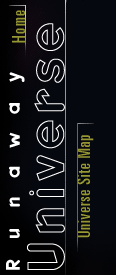 |

|
Resources
Links |
Books and Articles |
Special Thanks |
Credits
Links
Structure and Evolution of the Universe Forum
http://cfa-www.harvard.edu/seuforum/
The Harvard-Smithsonian Center for Astrophysics and NASA's Office of Space Science jointly created this beautiful Web site for scientists, teachers, and students alike. The site is an excellent starting point for anyone interested in learning about the universe and features research, interviews, images, and an idea exchange forum on a wide range of topics related to the structure and evolution of the universe.
High-Z Supernova Search Team
http://cfa-www.harvard.edu/cfa/oir/Research/supernova/HighZ.html
Supernova Cosmology Project
http://www-supernova.lbl.gov/
The physicists and astronomers who worked on the High-Z Supernova Search
Team and the Supernova Cosmology Project are the ones who determined that
the universe is expanding at an accelerating rate. These sites explain the
project, named the "Science Magazine Breakthrough of the Year" in 1998,
bringing it to life with images from the Hubble Space Telescope. To find out
more about the project and the scientists involved, check out these two
sites.
Sloan Digital Sky Survey
http://www.sdss.org
The Sloan Digital Sky Survey aims to systematically map one quarter of the entire sky, producing a detailed image and determining the positions of over 100 million celestial objects. The data and images from this ambitious work-in-progress, which recently located the most distant object ever observed, are available and regularly updated on the SDSS Web site.
VLT Astronomical Images
http://eso.org/outreach/gallery/astro/
VLT, the "Very Large Telescope" operated by the European Southern Observatory (ESO) in Atacama, Chile, is the world's most advanced optical telescope. The stunning photographs taken through VLT's lens are archived and updated at this ESO Web site.
Structure and Evolution of the Universe
http://universe.gsfc.nasa.gov
Maintained by NASA's Goddard Space Flight Center, this Web site may be the only place where you'll find Generation-X defined as "a future ultra-large-aperture x-ray telescope intended to observe the x-ray universe." GSFC's site is a universe unto itself, loaded with detailed data archives, documents and papers, image libraries, and links to other sites dealing with space.
Astronomical Data Center
http://adc.gsfc.nasa.gov
Though the ADC, also run by NASA's Goddard Space Center, functions primarily as an archive and distribution center of data that have been published by professional astronomers, there is plenty of information at this site that will be useful and comprehensible to the astronomy novice or hobbyist. If, for example, you're interested in pinpointing the 20 nearest stars or the 100 brightest stars the next time you look up at night, this site can show you how.
Books and Articles
The Accelerating Universe: Infinite Expansion, the Cosmological Constant, and the Beauty of the Cosmos.
By Mario Livio.
New York: John Wiley & Sons, Inc, 2000.
This book offers a clear and easily digestible explanation of how recent evidence that the universe is expanding at an accelerated rate is impacting cosmology. It also covers a range of topics relating to astrophysics, including a more in-depth description of supernovae than described in Birth of a Supernova.
Einstein: A Life.
By Denis Brian.
New York: John Wiley & Sons, 1996.
Why did Einstein call his cosmological constant his biggest blunder? Find out in this comprehensive biography. In addition to providing an intimate portrayal of the 20th century's greatest scientist, the author makes accessible some of the great thinker's theories and experiments.
The Runaway Universe: The Race to Discover the Future of the Cosmos.
By Donald Goldsmith.
Cambridge, Massachusetts: Perseus Books, 2000.
A fine introduction to cosmology and astrophysics, this book also tells the story of the astronomers who have discovered that the expansion of the universe is accelerating and the consequences of these findings. It also reveals how tentative these findings are.
The Whole Shebang: A State-of-the-Universe(s) Report.
By Timothy Ferris.
Simon & Schuster, 1997.
A clear and comprehensive account of how we know what we know in the field of cosmology.
"Hubble Warrior."
By Sally Stephens.
Astronomy, March 2000.
This article profiles Wendy Freedman, a cosmologist who finds herself at the center of the raging debate about how old and big the cosmos is and how fast it is expanding.
Special Thanks
Robert Patterson, Stuart Levy, Donna Cox, NCSA/UIUC (National Center for Supercomputing Applications, University of Illinois at Urbana-Champaign.)
Frank Summers, Hayden Planetarium, American Museum of Natural History
Credits
Lauren Aguirre, Executive Editor
David Colarusso, Intern
Molly Frey, Technologist
Rick Groleau, Managing Editor
Brenden Kootsey, Technologist
Lexi Krock, Editorial Assistant
Lingi Liu, Assistant Designer
David May, Intern
Peter Tyson, Editor in Chief
Anya Vinokour, Senior Designer
We would like to thank Tom Lucas, producer and writer of the NOVA program Runaway Universe and Brent Tully, the program's science director and co-producer, for their invaluable assistance in providing visual resources and editorial feedback in the creation of this Web site.
Disclaimer
Any opinions, findings and conclusions, or recommendations expressed in this Web site are those of the authors and do not necessarily reflect those of the National Science Foundation, a co-funder of this site.
History of the Universe |
Birth of a Supernova |
Tour the Universe
Moving Targets |
How Big is the Universe? |
Spin a Spiral Galaxy
Resources |
Transcript |
Site Map |
Runaway Universe Home
Editor's Picks |
Previous Sites |
Join Us/E-mail |
TV/Web Schedule
About NOVA |
Teachers |
Site Map |
Shop |
Jobs |
Search |
To print
PBS Online |
NOVA Online |
WGBH
© | Updated November 2000
|
|
|